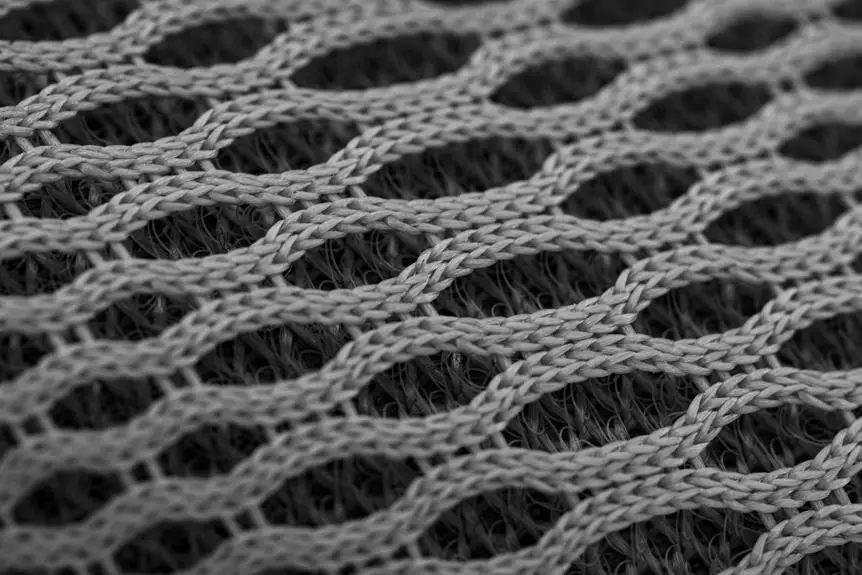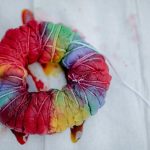You've probably noticed how some fabrics lose their vibrant colors over time, and it can be frustrating. Understanding what causes this fading is crucial for preserving your textiles. Common culprits include harsh washing techniques, the type of dye, and even sunlight exposure. But knowing the causes isn't enough; there are effective solutions to combat fading as well. If you want to ensure your favorite pieces stay looking fresh, you'll need to explore both preventative measures and restoration techniques. What you discover might change how you care for your fabrics forever.
Table of Contents
Key Takeaways
- Fabric fading is primarily caused by washing techniques, harsh detergents, and frequent exposure to sunlight.
- Using UV-blocking films, curtains, or blinds can significantly reduce sunlight exposure on fabrics.
- Opt for synthetic dyes and color-safe detergents to enhance fabric longevity and prevent fading.
- Washing in cold water and selecting gentle cycles minimizes wear and preserves color vibrancy.
Common Causes of Fabric Fading
Several factors can lead to fabric fading, including exposure to sunlight, washing techniques, and the type of dye used.
One of the most significant causes of fading is how you wash your clothes. Using hot water or harsh detergents can break down the fibers and cause colors to bleed. Always check the care labels and consider using cold water to preserve those vibrant hues.
Another factor is the type of dye used in the fabric. Some dyes are more resistant to fading than others. Natural dyes, for instance, tend to fade faster than synthetic ones. If you're investing in quality clothing, it's worth looking into the dye process and choosing items that use fade-resistant techniques.
You should also consider the frequency of wear. The more you wear and wash an item, the more likely it's to fade. Try to rotate your wardrobe to minimize wear on your favorite pieces.
Impact of Sunlight Exposure
One major factor contributing to fabric fading is prolonged exposure to sunlight, which can significantly weaken fibers and cause colors to diminish over time. When you leave your fabrics, whether it's curtains, upholstery, or clothing, in direct sunlight for extended periods, ultraviolet (UV) rays penetrate the material. This exposure breaks down the chemical bonds in the dyes, leading to a noticeable loss of vibrancy.
To protect your fabrics, consider rearranging your living space to minimize direct sunlight on your textiles. Use curtains or blinds to filter light effectively. If you love natural light, opt for UV-protective window films or treatments that can cut down harmful rays while still brightening your space.
When it comes to outdoor fabrics, look for options specifically designed to resist fading from sunlight. These materials often have built-in UV protection, making them more durable in sunny environments.
If you notice fading, you might want to rotate your items regularly, allowing all sides to experience equal exposure to sunlight. By taking these steps, you can preserve the beauty and longevity of your fabrics, ensuring they remain vibrant and fresh for years to come.
Role of Detergents and Chemicals
Detergents and chemicals can break down fabric fibers and dyes, accelerating the fading process if used improperly. When you choose a detergent, consider its ingredients carefully. Harsh chemicals, such as bleach or strong surfactants, may effectively clean your clothes but can also strip away color and weaken fibers over time.
You should opt for detergents specifically formulated for color protection. These products often contain enzymes and gentle surfactants that lift dirt without compromising the integrity of the fabric. Additionally, avoid using too much detergent, as excess can leave residue that wears on your clothes and enhances fading.
It's crucial to pay attention to the water temperature as well. Hot water can exacerbate the effects of certain detergents, leading to quicker fading. Instead, stick to cold or lukewarm water for washing colored fabrics.
Washing Techniques to Avoid
When it comes to preserving your fabrics, the washing techniques you choose can make a big difference.
You'll want to pay close attention to water temperature and the type of detergent you use to prevent fading.
Let's explore which practices to steer clear of for the best results.
Water Temperature Considerations
Using hot water can cause your fabrics to fade more quickly, so it's best to stick with cooler temperatures during washing. Hot water opens up the fibers in your fabrics, making them more susceptible to losing color. This is especially true for darker or brightly colored items, which can bleed and lose their vibrancy.
When you wash your clothes, consider using cold or lukewarm water instead. This not only helps maintain the color but also saves energy, making it an eco-friendly choice. If you're dealing with stubborn stains, pre-treat those spots with a stain remover rather than cranking up the water temperature.
It's also essential to pay attention to the washing machine settings. Opt for gentle cycles when possible, as they're less abrasive on fabrics. High agitation can contribute to fading, especially when combined with hot water.
Detergent Selection Tips
Choosing the right detergent can make a significant difference in preserving your fabrics' colors and preventing fading.
Start by avoiding harsh detergents that contain bleach or strong chemicals, as these can strip away color and weaken fibers. Opt for a gentle, color-safe detergent specifically formulated for delicate fabrics.
Pay attention to the pH level of the detergent too; a neutral pH is ideal for maintaining colors. Also, consider using liquid detergents instead of powders, as powders can leave residues that may dull fabrics over time.
When it comes to washing, don't overload your machine. This can prevent proper cleaning and rinsing, leading to detergent buildup on your clothes. Always follow the manufacturer's instructions on detergent amounts; using more won't enhance cleaning power and can actually harm your fabrics.
Lastly, always test a small, inconspicuous area of fabric before using a new detergent to ensure it won't cause fading or damage.
Preventative Measures for Longevity
To keep your fabrics looking fresh, you'll want to focus on a few key strategies.
Proper washing techniques, ideal storage conditions, and UV protection strategies can make a big difference in longevity.
Proper Washing Techniques
Proper washing techniques can significantly enhance the longevity of your fabrics, preserving their color and texture for years to come.
First, always check the care labels on your garments. They provide essential instructions tailored to each fabric type. When possible, opt for cold water washes, as hot water can accelerate fading and shrinkage.
Use a gentle cycle for delicate fabrics to minimize agitation, which can lead to wear and tear. When it comes to detergents, choose a mild, color-safe option to protect vibrant hues. Avoid bleach, as it can strip colors and weaken fibers over time.
Additionally, consider washing similar colors together to prevent dye transfer. If you're concerned about fading, try turning garments inside out before washing; this protects the outer surface from friction and exposure to detergent.
Limit your use of the dryer; air-drying is gentler on fabric and helps maintain its original shape. If you must use a dryer, select a low heat setting.
Ideal Storage Conditions
Creating ideal storage conditions is crucial for keeping your fabrics looking their best and preventing fading over time. When you store your textiles properly, you'll help maintain their colors and integrity for the long haul. Here are four key factors to consider for optimal storage:
- Temperature Control: Keep your storage space cool and dry. Excessive heat can weaken fibers, while humidity promotes mold, both of which contribute to fading.
- Breathable Containers: Use cotton or linen bags instead of plastic. This allows air circulation, preventing moisture buildup that can lead to discoloration.
- Avoid Overcrowding: Don't pack your fabrics too tightly. Allowing space prevents creases and reduces the risk of fading caused by constant friction.
- Organized Folding: Fold your fabrics neatly to minimize wrinkles. Use acid-free tissue paper between layers to provide cushioning and protect delicate surfaces.
UV Protection Strategies
Storing your fabrics in ideal conditions is just the first step; protecting them from UV exposure is key to preventing fading and preserving their vibrant colors.
One effective strategy is to use UV-blocking window films or shades. These can significantly reduce the amount of harmful sunlight that reaches your fabrics, especially if they're displayed in sunny areas.
When it comes to furniture and upholstery, consider applying a UV protectant spray. This product can create a barrier against UV rays, helping to maintain the original color and texture of your fabrics. If you're planning to display your fabrics, opt for items that are lined or backed with UV-resistant materials.
Additionally, rotating your fabrics regularly can help minimize uneven fading, especially for items exposed to sunlight. If possible, take your fabrics indoors during peak sunlight hours or during prolonged sunny spells.
Lastly, investing in a fabric protector that contains UV inhibitors can offer an extra layer of defense. By implementing these UV protection strategies, you'll enhance the longevity of your fabrics and keep them looking fresh and vibrant for years to come.
Restoration Techniques for Faded Fabrics
To restore faded fabrics, you can employ various techniques that rejuvenate colors and extend the lifespan of your textiles. Here are some effective methods to bring your beloved items back to life:
- Dyeing: Use fabric dye specifically formulated for the type of material you're working with. This can reintroduce vibrant hues and cover up fading effectively.
- Fabric Paint: If dyeing seems daunting, fabric paint offers a more controlled approach. You can touch up faded areas or create a unique design, enhancing the fabric's appeal.
- Color Restorers: These products, available in spray or wash form, can restore color without the need for extensive processes. Look for ones that suit your fabric type for best results.
- Sunlight and Heat: Sometimes, simply exposing the fabric to sunlight or applying gentle heat can revitalize its colors. Just be cautious, as too much exposure can cause further fading.
Frequently Asked Questions
Can Fabric Fading Affect the Strength of the Material?
Yes, fabric fading can affect the strength of the material. When fibers degrade due to exposure to sunlight or harsh chemicals, they weaken, making the fabric more prone to tearing and other damage over time.
Are Certain Fabrics More Prone to Fading Than Others?
Yes, certain fabrics are definitely more prone to fading than others. For instance, cotton and linen fade quicker under sunlight, while synthetic materials like polyester resist fading better. Choosing the right fabric can help maintain color vibrancy.
How Does Humidity Influence Fabric Fading Rates?
Humidity affects fabric fading by increasing moisture levels, which can weaken dyes and fibers. When you expose fabrics to high humidity, you'll likely notice faster fading, especially in vibrant colors and delicate materials.
What Role Does Fabric Dye Quality Play in Fading?
Fabric dye quality significantly influences fading. When you choose high-quality dyes, they're more resistant to fading from sunlight and washing. Low-quality dyes, however, can lead to faster color loss, diminishing your fabric's vibrancy over time.
Can Fading Be Reversed by Re-Dyeing Fabrics?
Yes, you can often reverse fading by re-dyeing fabrics. It refreshes the color, but results vary based on the fabric type and dye quality. Test a small area first to ensure satisfaction before proceeding.
- Tetron Fabric for Marine Applications: Durability and Use Cases - June 18, 2025
- Tetron Fabric for Outdoor Furniture: Weather Resistance and Care - June 18, 2025
- Tetron Fabric for Wall Coverings: Style and Application Tips - June 18, 2025







